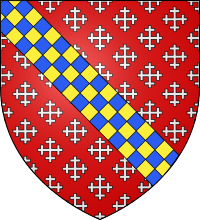William de Ormesby facts for kids
Quick facts for kids
William de Ormesby
|
|
|---|---|

Arms of William de Ormesby
Gules, crusilly argent, a bend chequy or and azure. |
|
| Personal details | |
| Died | 1317 |
William de Ormesby was an important English judge who lived a long time ago, from the 1200s into the 1300s. He is best known for being the top judge, or "Justice," in Scotland for a short time between 1296 and 1297. This was right after England took control of Scotland.
Contents
William de Ormesby's Life Story
Early Career and Royal Appointments
William de Ormesby's family came from a village called Ormesby in East Norfolk, England. He began his career as a judge in the late 1200s.
On April 10, 1292, he was given an important job. He became a "justice in eyre." This meant he traveled to different counties like Lancashire, Westmoreland, and Cumberland. His job was to hear legal cases and complaints. He also had a special task to listen to problems people had with the king's own officials. Later that year, his area of work grew to include Northumberland.
In 1296, William de Ormesby became a judge in the King's Bench. This was one of the most important courts in England.
Role as Justice of Scotland
After England invaded Scotland in 1296, King Edward I of England returned from his journey through Scotland. He met William de Ormesby at a place called Berwick. At this meeting, King Edward I chose Ormesby to be the "Justice of Scotland." This made Ormesby the main legal authority in Scotland for the English king.
King Edward I asked Ormesby to make all the Scottish landowners promise loyalty to him. Ormesby did this very strictly. He didn't show special treatment to anyone. He even forced people who refused to swear loyalty to leave Scotland.
Challenges and Later Duties
Two important English leaders, John de Warenne and Hugh de Cressingham, were away in England. This meant William de Ormesby had a lot of responsibility for King Edward's strict rule over the Scots.
In May 1297, a Scottish revolt began, led by William Wallace. Wallace attacked Ormesby at Scone. Luckily, Ormesby got a warning at the last minute. He managed to escape, but he had to leave all his personal belongings behind.
After the English lost the Battle of Stirling Bridge on September 11, Ormesby was given a new task. On October 23, he was told to gather foot soldiers. These soldiers were needed from areas like Northumberland and Yorkshire for the next fight against the Scots.
In March 1298, he was called to a meeting in London. He continued his work at the King's Bench court. In 1305, he was also the main judge for special legal investigations in Norfolk and Suffolk. These investigations were called "trailbaston."
Final Years and Legacy
William de Ormesby continued to serve as a judge even when Edward II of England became king. We don't know if he stayed at the King's Bench court. However, he was still called to attend Parliament with other judges until he died. He also worked as a judge for local court sessions, known as "assizes," especially in the eastern parts of England like Norfolk and Suffolk.
In April 1311, Ormesby was one of four judges chosen to work in the "common pleas" courts. These courts dealt with everyday legal cases in the area of Durham.
William de Ormesby passed away before June 12, 1317. On that date, his assistants were told to send his court records and documents to the king. He was buried at the Benedictine monastery of St. Benet's in Hulme.
Family Life
William de Ormesby was married to a woman named Sybilla. She was the widow of Roger Loveday.

